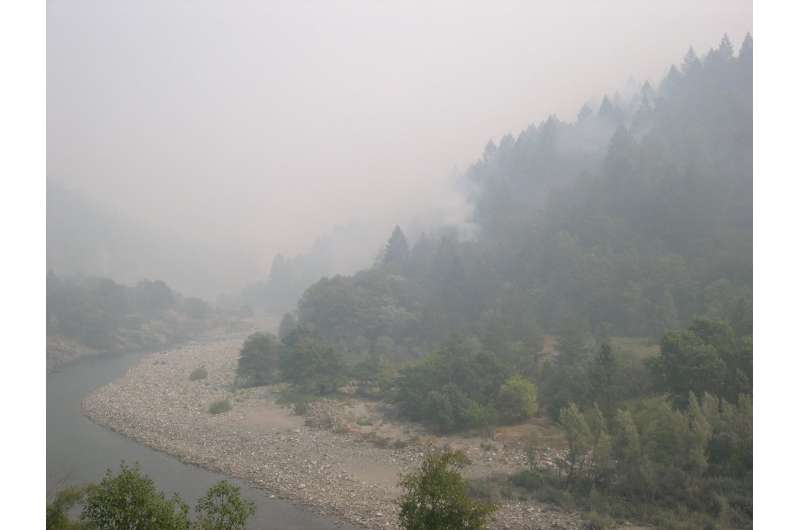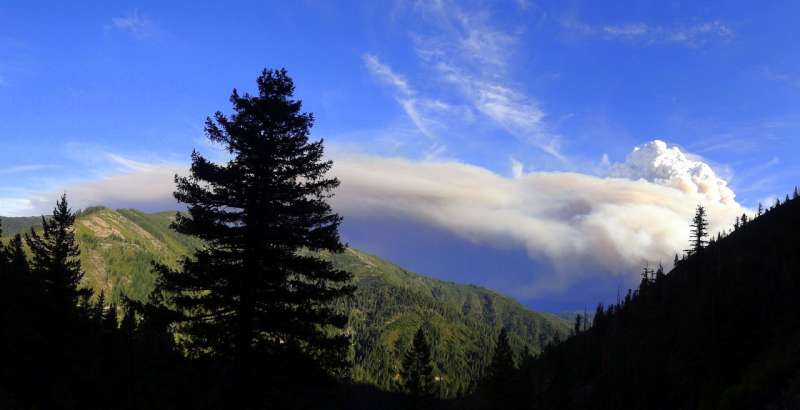Smoke from wildfires has cooling effect on water temperatures

Smoke generated by wildfires can cool river and stream water temperatures by reducing solar radiation and cooling air temperatures, according to a new study in California's Klamath River Basin.
A new study published in Water Resources Research, a journal of the American Geophysical Union, suggests smoke-induced cooling has the potential to benefit aquatic species that require cool water to survive because high summer water temperatures are a major factor contributing to population declines, and wildfires are more likely to occur during the warmest and driest time of year.
Native American tribes and other entities measuring river water temperatures in the Klamath Basin had previously noticed drops in river temperatures during periods of heavy smoke, but this is the first study to demonstrate this phenomenon with rigorous statistical analysis of long-term datasets.
Frank Lake, a research ecologist with the U.S. Forest Service's Pacific Southwest Research Station in Albany, California and co-author of the study says historical wildfire patterns are quite different than those of present day, yet likely share similarities in regard to this new concept.
"Prior to modern fire suppression, wildfires burned extensively throughout much of the Western United States, and smoke from these fires may have naturally cooled water temperatures during the summer when temperatures are hottest," Lake said.

Bill Tripp, deputy director of the Karuk Tribe Department of Natural Resources in Orleans, California, who was not connected to the new study, says this research provides a great example of how traditional ecological knowledge is used to focus a refined view under the western scientific framework and better understand the specific functions these processes provide.
"The ecological principles explored here are in no way new," Tripp said. "In fact, there are cultural burning practices associated with Karuk World Renewal Ceremonies specifically for the purpose of 'calling in the salmon' that are directly connected to these factors."
This study analyzed ground-based measurements of water, air and river hydrological data collected from stations throughout the lower Klamath River Basin in correlation with atmospheric smoke data derived from NASA satellite imagery. In total, the data encompassed six years of extensive wildfire occurrence between 2006 and 2015.
LeRoy Cyr, a fish biologist with the Six Rivers National Forest in Eureka, California, says this research is a result of a long-term collaborative effort.
"Over 20 years ago, we set out to answer some basic research questions when we began our collaborative stream temperature monitoring at numerous sites along the lower-mid Klamath River," Cyr said. "This pattern that emerged from the data is advancing our understanding of the cooling effects of smoke from wildland fires and the beneficial effects to salmonid survival during our critical summer period."
More information: Aaron T. David et al. Wildfire Smoke Cools Summer River and Stream Water Temperatures, Water Resources Research (2018). DOI: 10.1029/2018WR022964
Journal information: Water Resources Research
Provided by American Geophysical Union
This story is republished courtesy of AGU Blogs (http://blogs.agu.org), a community of Earth and space science blogs, hosted by the American Geophysical Union. Read the original story here.



















